HRM Systems & Procedures: Achieving Business Objectives at Deloitte
VerifiedAdded on 2023/06/13
|15
|4848
|149
Report
AI Summary
This report provides an in-depth analysis of Human Resource Management (HRM) functions within an organizational context, focusing on Deloitte, a multinational professional services network. It highlights the crucial role of HR in recruitment, training, employee relations, and maintaining company culture. The report examines the effectiveness of recruitment and selection strategies in maintaining organizational performance, including the use of employee testimonials, social media engagement, and talent networks. It also explores approaches to talent management, emphasizing employee development and employer-employee relations. Furthermore, the report investigates HR systems and procedures, such as preliminary screenings and multi-stage interviews, and how they enable the achievement of business objectives, emphasizing Deloitte's people-oriented policies and commitment to a diverse and inclusive work environment. Desklib offers a range of resources, including past papers and solved assignments, to support students in their studies.
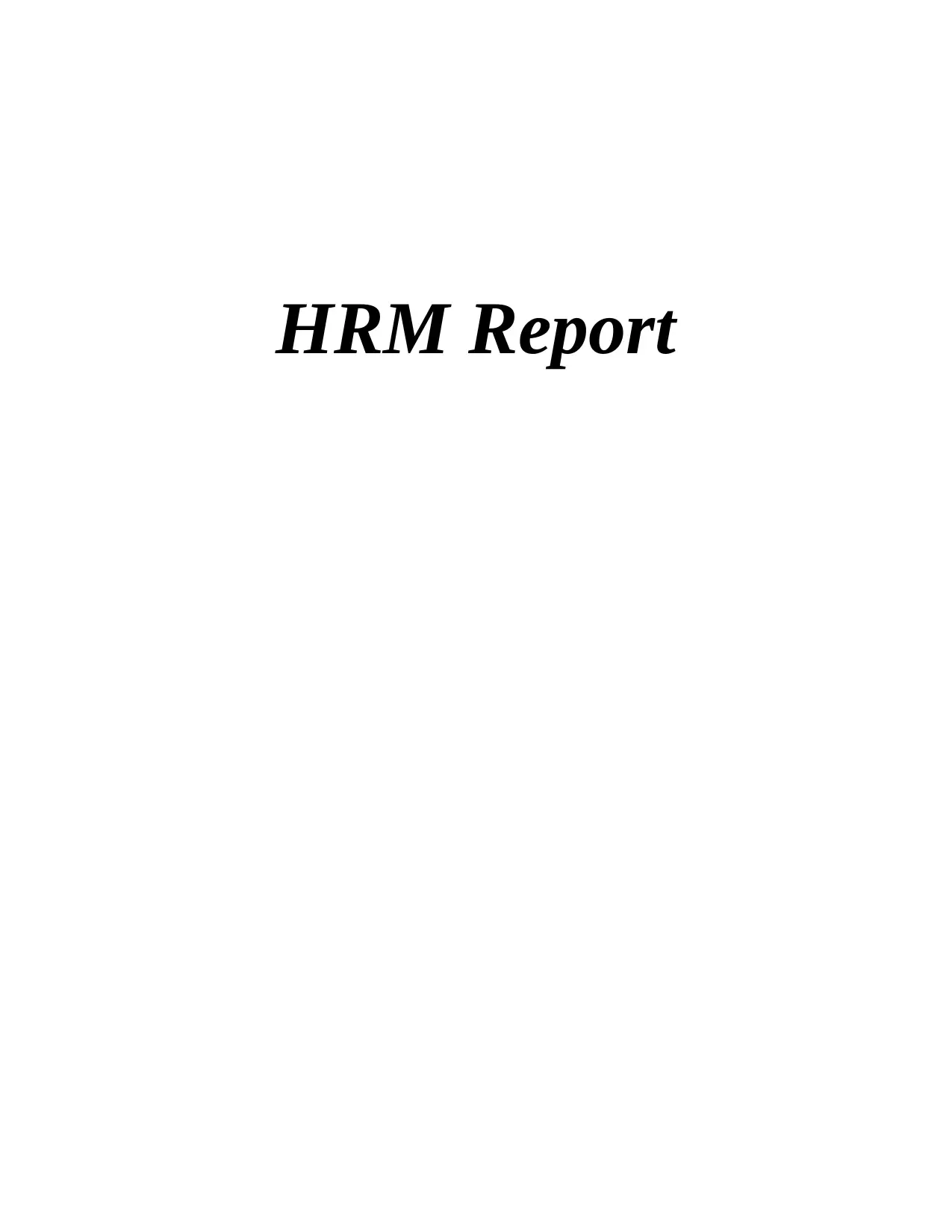
HRM Report
Paraphrase This Document
Need a fresh take? Get an instant paraphrase of this document with our AI Paraphraser
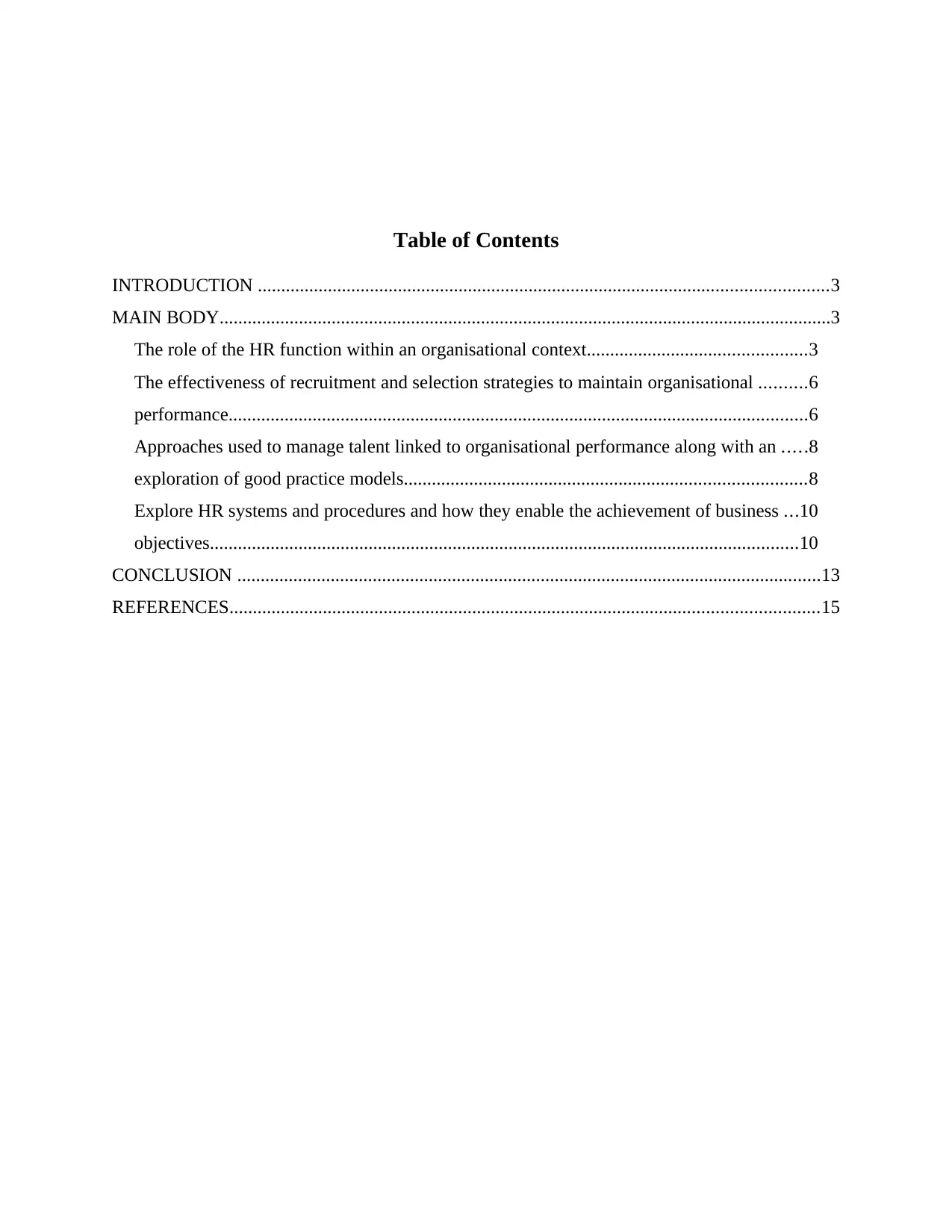
Table of Contents
INTRODUCTION ..........................................................................................................................3
MAIN BODY...................................................................................................................................3
The role of the HR function within an organisational context...............................................3
The effectiveness of recruitment and selection strategies to maintain organisational ..........6
performance............................................................................................................................6
Approaches used to manage talent linked to organisational performance along with an .....8
exploration of good practice models......................................................................................8
Explore HR systems and procedures and how they enable the achievement of business ...10
objectives..............................................................................................................................10
CONCLUSION .............................................................................................................................13
REFERENCES..............................................................................................................................15
INTRODUCTION ..........................................................................................................................3
MAIN BODY...................................................................................................................................3
The role of the HR function within an organisational context...............................................3
The effectiveness of recruitment and selection strategies to maintain organisational ..........6
performance............................................................................................................................6
Approaches used to manage talent linked to organisational performance along with an .....8
exploration of good practice models......................................................................................8
Explore HR systems and procedures and how they enable the achievement of business ...10
objectives..............................................................................................................................10
CONCLUSION .............................................................................................................................13
REFERENCES..............................................................................................................................15
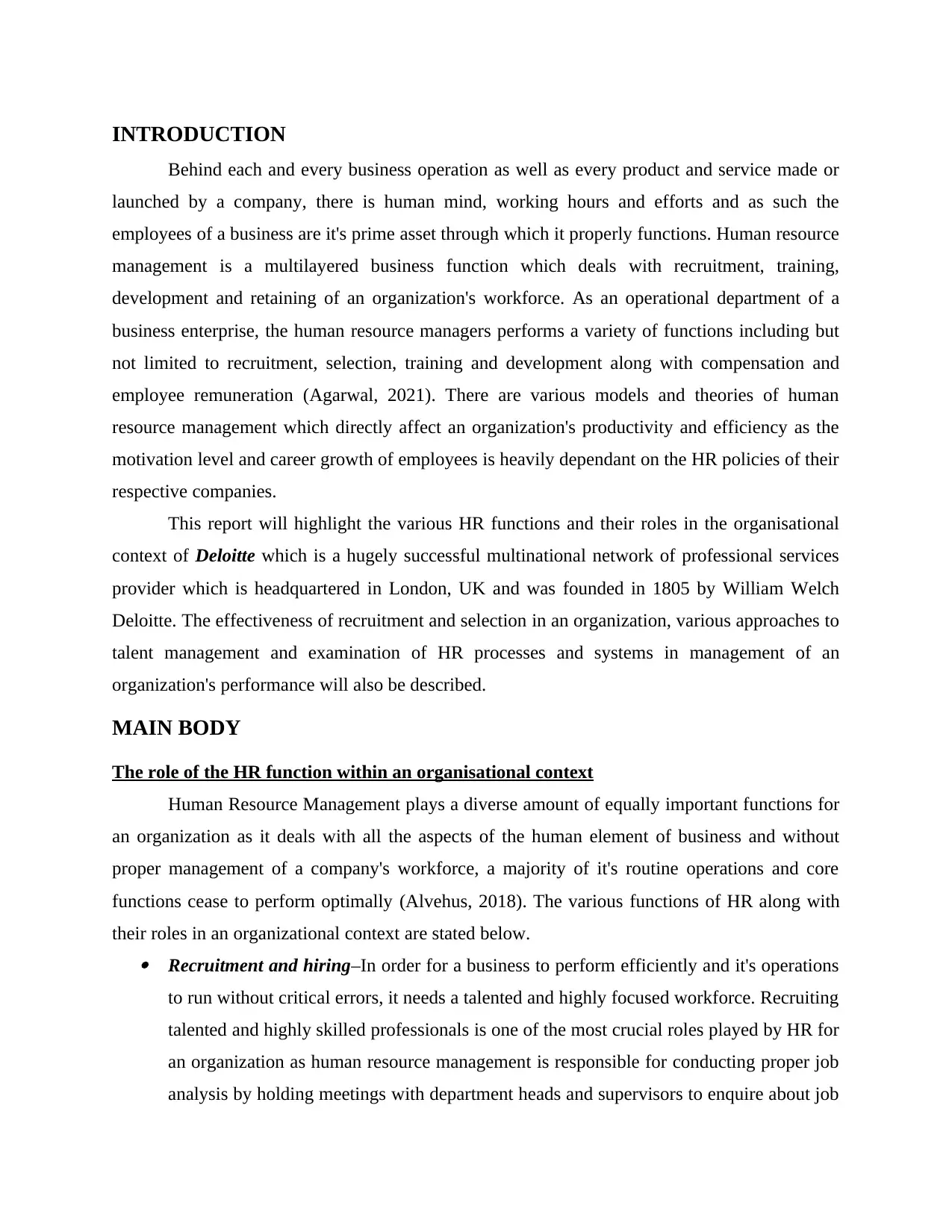
INTRODUCTION
Behind each and every business operation as well as every product and service made or
launched by a company, there is human mind, working hours and efforts and as such the
employees of a business are it's prime asset through which it properly functions. Human resource
management is a multilayered business function which deals with recruitment, training,
development and retaining of an organization's workforce. As an operational department of a
business enterprise, the human resource managers performs a variety of functions including but
not limited to recruitment, selection, training and development along with compensation and
employee remuneration (Agarwal, 2021). There are various models and theories of human
resource management which directly affect an organization's productivity and efficiency as the
motivation level and career growth of employees is heavily dependant on the HR policies of their
respective companies.
This report will highlight the various HR functions and their roles in the organisational
context of Deloitte which is a hugely successful multinational network of professional services
provider which is headquartered in London, UK and was founded in 1805 by William Welch
Deloitte. The effectiveness of recruitment and selection in an organization, various approaches to
talent management and examination of HR processes and systems in management of an
organization's performance will also be described.
MAIN BODY
The role of the HR function within an organisational context
Human Resource Management plays a diverse amount of equally important functions for
an organization as it deals with all the aspects of the human element of business and without
proper management of a company's workforce, a majority of it's routine operations and core
functions cease to perform optimally (Alvehus, 2018). The various functions of HR along with
their roles in an organizational context are stated below. Recruitment and hiring–In order for a business to perform efficiently and it's operations
to run without critical errors, it needs a talented and highly focused workforce. Recruiting
talented and highly skilled professionals is one of the most crucial roles played by HR for
an organization as human resource management is responsible for conducting proper job
analysis by holding meetings with department heads and supervisors to enquire about job
Behind each and every business operation as well as every product and service made or
launched by a company, there is human mind, working hours and efforts and as such the
employees of a business are it's prime asset through which it properly functions. Human resource
management is a multilayered business function which deals with recruitment, training,
development and retaining of an organization's workforce. As an operational department of a
business enterprise, the human resource managers performs a variety of functions including but
not limited to recruitment, selection, training and development along with compensation and
employee remuneration (Agarwal, 2021). There are various models and theories of human
resource management which directly affect an organization's productivity and efficiency as the
motivation level and career growth of employees is heavily dependant on the HR policies of their
respective companies.
This report will highlight the various HR functions and their roles in the organisational
context of Deloitte which is a hugely successful multinational network of professional services
provider which is headquartered in London, UK and was founded in 1805 by William Welch
Deloitte. The effectiveness of recruitment and selection in an organization, various approaches to
talent management and examination of HR processes and systems in management of an
organization's performance will also be described.
MAIN BODY
The role of the HR function within an organisational context
Human Resource Management plays a diverse amount of equally important functions for
an organization as it deals with all the aspects of the human element of business and without
proper management of a company's workforce, a majority of it's routine operations and core
functions cease to perform optimally (Alvehus, 2018). The various functions of HR along with
their roles in an organizational context are stated below. Recruitment and hiring–In order for a business to perform efficiently and it's operations
to run without critical errors, it needs a talented and highly focused workforce. Recruiting
talented and highly skilled professionals is one of the most crucial roles played by HR for
an organization as human resource management is responsible for conducting proper job
analysis by holding meetings with department heads and supervisors to enquire about job
⊘ This is a preview!⊘
Do you want full access?
Subscribe today to unlock all pages.

Trusted by 1+ million students worldwide
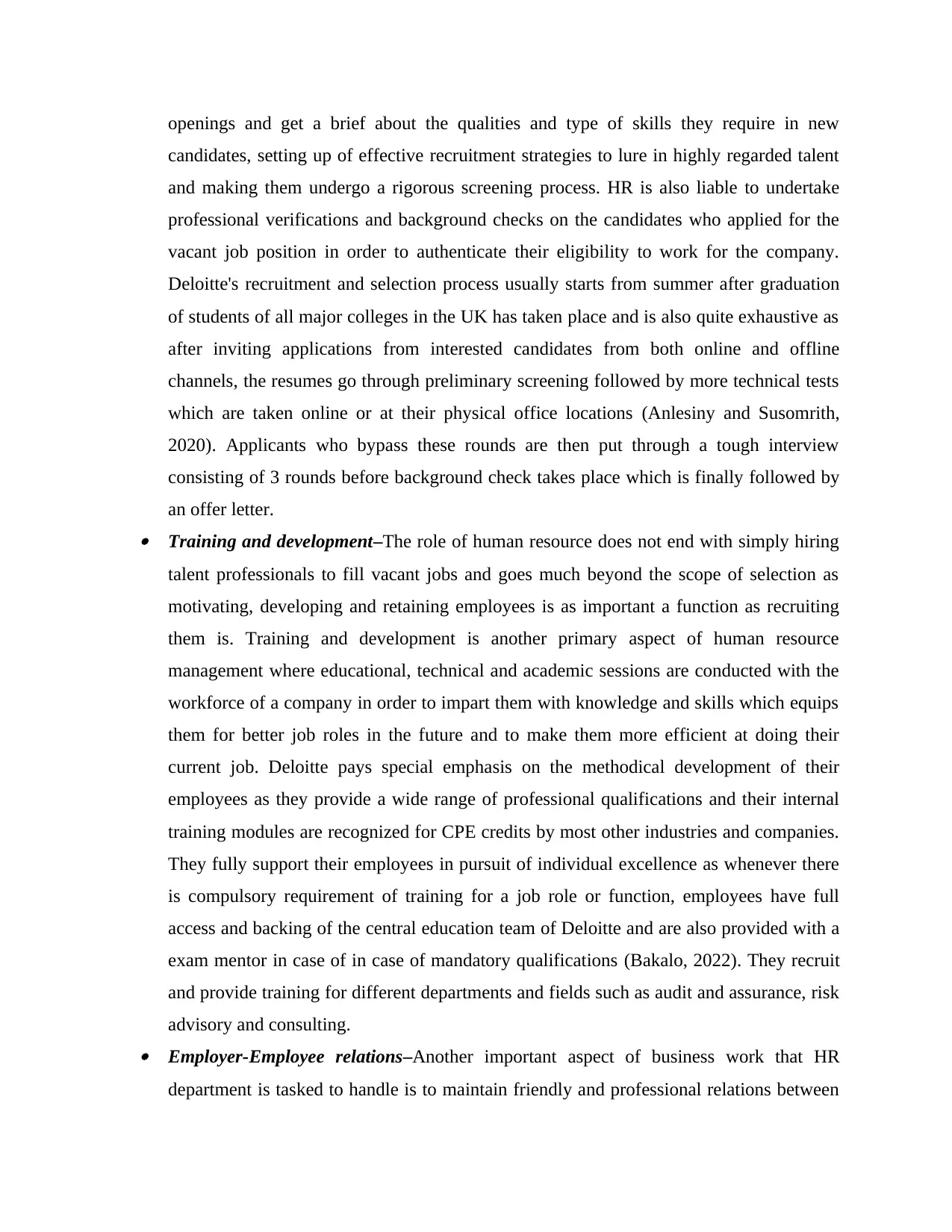
openings and get a brief about the qualities and type of skills they require in new
candidates, setting up of effective recruitment strategies to lure in highly regarded talent
and making them undergo a rigorous screening process. HR is also liable to undertake
professional verifications and background checks on the candidates who applied for the
vacant job position in order to authenticate their eligibility to work for the company.
Deloitte's recruitment and selection process usually starts from summer after graduation
of students of all major colleges in the UK has taken place and is also quite exhaustive as
after inviting applications from interested candidates from both online and offline
channels, the resumes go through preliminary screening followed by more technical tests
which are taken online or at their physical office locations (Anlesiny and Susomrith,
2020). Applicants who bypass these rounds are then put through a tough interview
consisting of 3 rounds before background check takes place which is finally followed by
an offer letter. Training and development–The role of human resource does not end with simply hiring
talent professionals to fill vacant jobs and goes much beyond the scope of selection as
motivating, developing and retaining employees is as important a function as recruiting
them is. Training and development is another primary aspect of human resource
management where educational, technical and academic sessions are conducted with the
workforce of a company in order to impart them with knowledge and skills which equips
them for better job roles in the future and to make them more efficient at doing their
current job. Deloitte pays special emphasis on the methodical development of their
employees as they provide a wide range of professional qualifications and their internal
training modules are recognized for CPE credits by most other industries and companies.
They fully support their employees in pursuit of individual excellence as whenever there
is compulsory requirement of training for a job role or function, employees have full
access and backing of the central education team of Deloitte and are also provided with a
exam mentor in case of in case of mandatory qualifications (Bakalo, 2022). They recruit
and provide training for different departments and fields such as audit and assurance, risk
advisory and consulting. Employer-Employee relations–Another important aspect of business work that HR
department is tasked to handle is to maintain friendly and professional relations between
candidates, setting up of effective recruitment strategies to lure in highly regarded talent
and making them undergo a rigorous screening process. HR is also liable to undertake
professional verifications and background checks on the candidates who applied for the
vacant job position in order to authenticate their eligibility to work for the company.
Deloitte's recruitment and selection process usually starts from summer after graduation
of students of all major colleges in the UK has taken place and is also quite exhaustive as
after inviting applications from interested candidates from both online and offline
channels, the resumes go through preliminary screening followed by more technical tests
which are taken online or at their physical office locations (Anlesiny and Susomrith,
2020). Applicants who bypass these rounds are then put through a tough interview
consisting of 3 rounds before background check takes place which is finally followed by
an offer letter. Training and development–The role of human resource does not end with simply hiring
talent professionals to fill vacant jobs and goes much beyond the scope of selection as
motivating, developing and retaining employees is as important a function as recruiting
them is. Training and development is another primary aspect of human resource
management where educational, technical and academic sessions are conducted with the
workforce of a company in order to impart them with knowledge and skills which equips
them for better job roles in the future and to make them more efficient at doing their
current job. Deloitte pays special emphasis on the methodical development of their
employees as they provide a wide range of professional qualifications and their internal
training modules are recognized for CPE credits by most other industries and companies.
They fully support their employees in pursuit of individual excellence as whenever there
is compulsory requirement of training for a job role or function, employees have full
access and backing of the central education team of Deloitte and are also provided with a
exam mentor in case of in case of mandatory qualifications (Bakalo, 2022). They recruit
and provide training for different departments and fields such as audit and assurance, risk
advisory and consulting. Employer-Employee relations–Another important aspect of business work that HR
department is tasked to handle is to maintain friendly and professional relations between
Paraphrase This Document
Need a fresh take? Get an instant paraphrase of this document with our AI Paraphraser
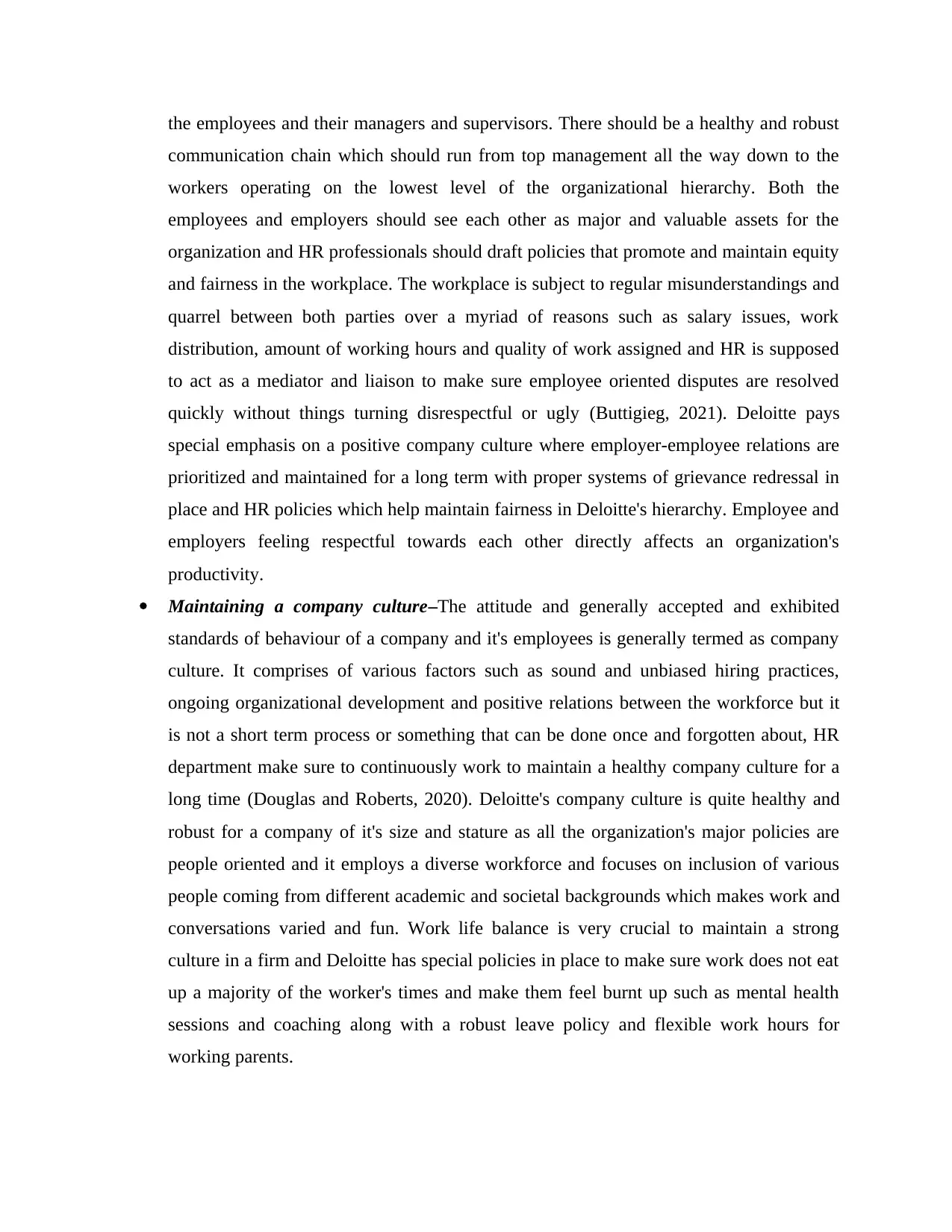
the employees and their managers and supervisors. There should be a healthy and robust
communication chain which should run from top management all the way down to the
workers operating on the lowest level of the organizational hierarchy. Both the
employees and employers should see each other as major and valuable assets for the
organization and HR professionals should draft policies that promote and maintain equity
and fairness in the workplace. The workplace is subject to regular misunderstandings and
quarrel between both parties over a myriad of reasons such as salary issues, work
distribution, amount of working hours and quality of work assigned and HR is supposed
to act as a mediator and liaison to make sure employee oriented disputes are resolved
quickly without things turning disrespectful or ugly (Buttigieg, 2021). Deloitte pays
special emphasis on a positive company culture where employer-employee relations are
prioritized and maintained for a long term with proper systems of grievance redressal in
place and HR policies which help maintain fairness in Deloitte's hierarchy. Employee and
employers feeling respectful towards each other directly affects an organization's
productivity.
Maintaining a company culture–The attitude and generally accepted and exhibited
standards of behaviour of a company and it's employees is generally termed as company
culture. It comprises of various factors such as sound and unbiased hiring practices,
ongoing organizational development and positive relations between the workforce but it
is not a short term process or something that can be done once and forgotten about, HR
department make sure to continuously work to maintain a healthy company culture for a
long time (Douglas and Roberts, 2020). Deloitte's company culture is quite healthy and
robust for a company of it's size and stature as all the organization's major policies are
people oriented and it employs a diverse workforce and focuses on inclusion of various
people coming from different academic and societal backgrounds which makes work and
conversations varied and fun. Work life balance is very crucial to maintain a strong
culture in a firm and Deloitte has special policies in place to make sure work does not eat
up a majority of the worker's times and make them feel burnt up such as mental health
sessions and coaching along with a robust leave policy and flexible work hours for
working parents.
communication chain which should run from top management all the way down to the
workers operating on the lowest level of the organizational hierarchy. Both the
employees and employers should see each other as major and valuable assets for the
organization and HR professionals should draft policies that promote and maintain equity
and fairness in the workplace. The workplace is subject to regular misunderstandings and
quarrel between both parties over a myriad of reasons such as salary issues, work
distribution, amount of working hours and quality of work assigned and HR is supposed
to act as a mediator and liaison to make sure employee oriented disputes are resolved
quickly without things turning disrespectful or ugly (Buttigieg, 2021). Deloitte pays
special emphasis on a positive company culture where employer-employee relations are
prioritized and maintained for a long term with proper systems of grievance redressal in
place and HR policies which help maintain fairness in Deloitte's hierarchy. Employee and
employers feeling respectful towards each other directly affects an organization's
productivity.
Maintaining a company culture–The attitude and generally accepted and exhibited
standards of behaviour of a company and it's employees is generally termed as company
culture. It comprises of various factors such as sound and unbiased hiring practices,
ongoing organizational development and positive relations between the workforce but it
is not a short term process or something that can be done once and forgotten about, HR
department make sure to continuously work to maintain a healthy company culture for a
long time (Douglas and Roberts, 2020). Deloitte's company culture is quite healthy and
robust for a company of it's size and stature as all the organization's major policies are
people oriented and it employs a diverse workforce and focuses on inclusion of various
people coming from different academic and societal backgrounds which makes work and
conversations varied and fun. Work life balance is very crucial to maintain a strong
culture in a firm and Deloitte has special policies in place to make sure work does not eat
up a majority of the worker's times and make them feel burnt up such as mental health
sessions and coaching along with a robust leave policy and flexible work hours for
working parents.
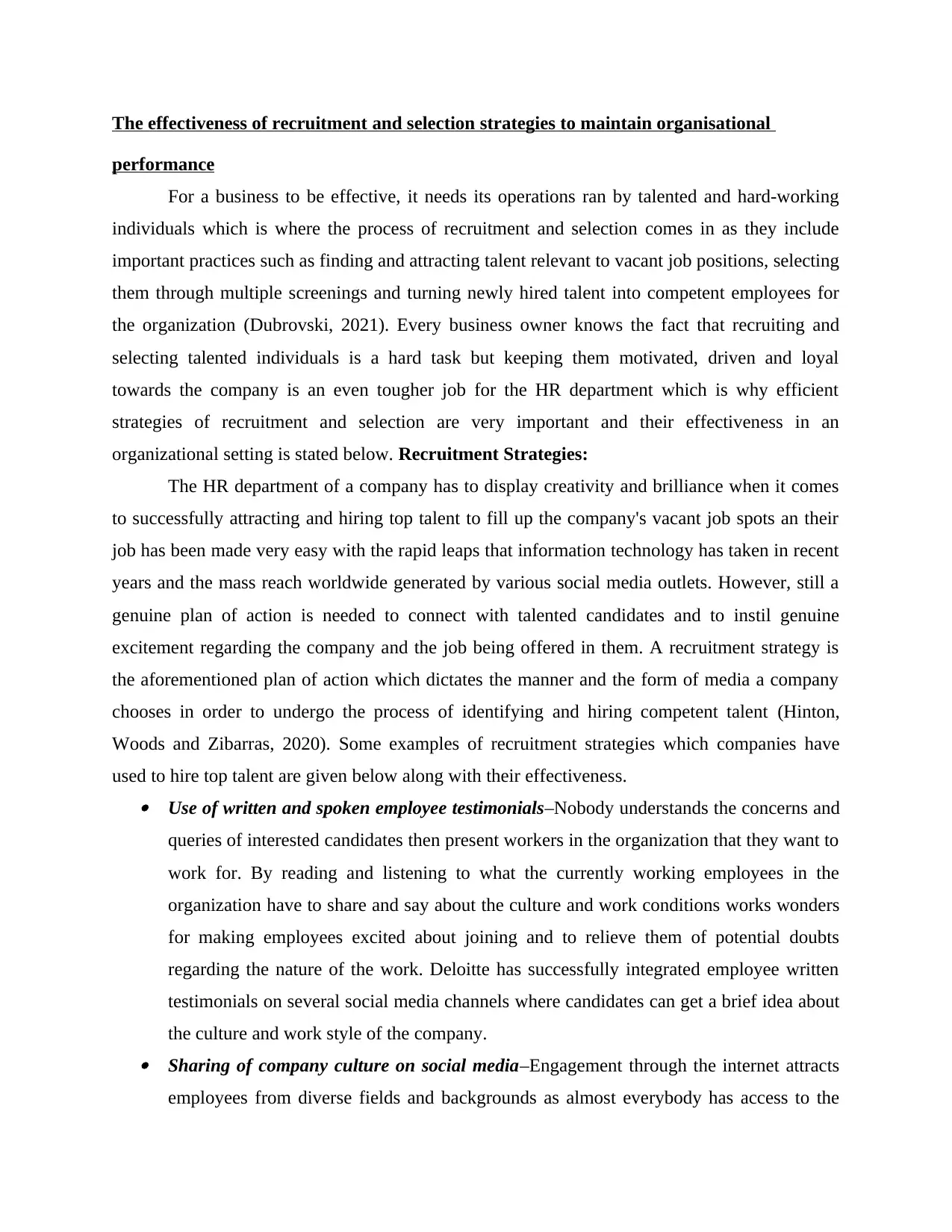
The effectiveness of recruitment and selection strategies to maintain organisational
performance
For a business to be effective, it needs its operations ran by talented and hard-working
individuals which is where the process of recruitment and selection comes in as they include
important practices such as finding and attracting talent relevant to vacant job positions, selecting
them through multiple screenings and turning newly hired talent into competent employees for
the organization (Dubrovski, 2021). Every business owner knows the fact that recruiting and
selecting talented individuals is a hard task but keeping them motivated, driven and loyal
towards the company is an even tougher job for the HR department which is why efficient
strategies of recruitment and selection are very important and their effectiveness in an
organizational setting is stated below. Recruitment Strategies:
The HR department of a company has to display creativity and brilliance when it comes
to successfully attracting and hiring top talent to fill up the company's vacant job spots an their
job has been made very easy with the rapid leaps that information technology has taken in recent
years and the mass reach worldwide generated by various social media outlets. However, still a
genuine plan of action is needed to connect with talented candidates and to instil genuine
excitement regarding the company and the job being offered in them. A recruitment strategy is
the aforementioned plan of action which dictates the manner and the form of media a company
chooses in order to undergo the process of identifying and hiring competent talent (Hinton,
Woods and Zibarras, 2020). Some examples of recruitment strategies which companies have
used to hire top talent are given below along with their effectiveness. Use of written and spoken employee testimonials–Nobody understands the concerns and
queries of interested candidates then present workers in the organization that they want to
work for. By reading and listening to what the currently working employees in the
organization have to share and say about the culture and work conditions works wonders
for making employees excited about joining and to relieve them of potential doubts
regarding the nature of the work. Deloitte has successfully integrated employee written
testimonials on several social media channels where candidates can get a brief idea about
the culture and work style of the company. Sharing of company culture on social media–Engagement through the internet attracts
employees from diverse fields and backgrounds as almost everybody has access to the
performance
For a business to be effective, it needs its operations ran by talented and hard-working
individuals which is where the process of recruitment and selection comes in as they include
important practices such as finding and attracting talent relevant to vacant job positions, selecting
them through multiple screenings and turning newly hired talent into competent employees for
the organization (Dubrovski, 2021). Every business owner knows the fact that recruiting and
selecting talented individuals is a hard task but keeping them motivated, driven and loyal
towards the company is an even tougher job for the HR department which is why efficient
strategies of recruitment and selection are very important and their effectiveness in an
organizational setting is stated below. Recruitment Strategies:
The HR department of a company has to display creativity and brilliance when it comes
to successfully attracting and hiring top talent to fill up the company's vacant job spots an their
job has been made very easy with the rapid leaps that information technology has taken in recent
years and the mass reach worldwide generated by various social media outlets. However, still a
genuine plan of action is needed to connect with talented candidates and to instil genuine
excitement regarding the company and the job being offered in them. A recruitment strategy is
the aforementioned plan of action which dictates the manner and the form of media a company
chooses in order to undergo the process of identifying and hiring competent talent (Hinton,
Woods and Zibarras, 2020). Some examples of recruitment strategies which companies have
used to hire top talent are given below along with their effectiveness. Use of written and spoken employee testimonials–Nobody understands the concerns and
queries of interested candidates then present workers in the organization that they want to
work for. By reading and listening to what the currently working employees in the
organization have to share and say about the culture and work conditions works wonders
for making employees excited about joining and to relieve them of potential doubts
regarding the nature of the work. Deloitte has successfully integrated employee written
testimonials on several social media channels where candidates can get a brief idea about
the culture and work style of the company. Sharing of company culture on social media–Engagement through the internet attracts
employees from diverse fields and backgrounds as almost everybody has access to the
⊘ This is a preview!⊘
Do you want full access?
Subscribe today to unlock all pages.

Trusted by 1+ million students worldwide
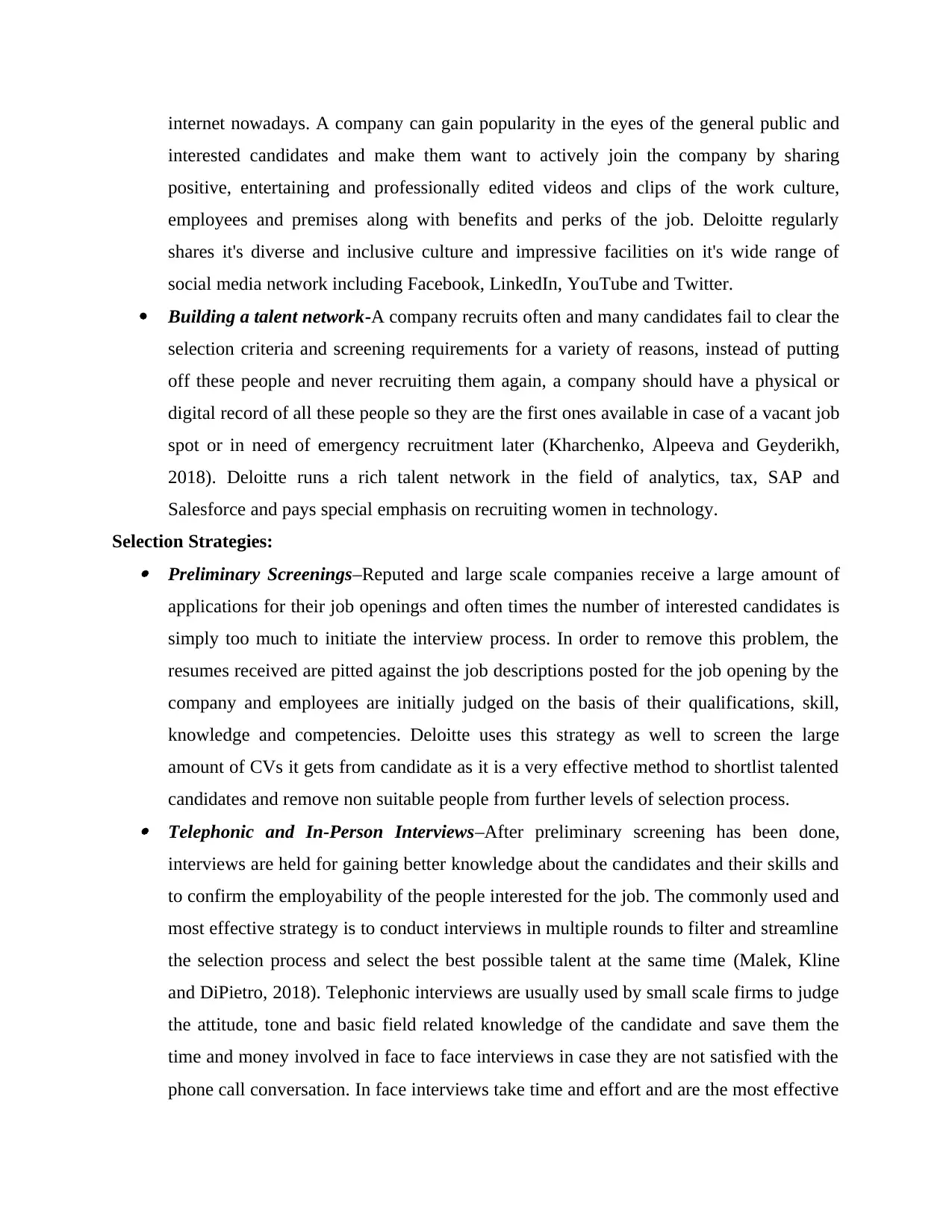
internet nowadays. A company can gain popularity in the eyes of the general public and
interested candidates and make them want to actively join the company by sharing
positive, entertaining and professionally edited videos and clips of the work culture,
employees and premises along with benefits and perks of the job. Deloitte regularly
shares it's diverse and inclusive culture and impressive facilities on it's wide range of
social media network including Facebook, LinkedIn, YouTube and Twitter.
Building a talent network-A company recruits often and many candidates fail to clear the
selection criteria and screening requirements for a variety of reasons, instead of putting
off these people and never recruiting them again, a company should have a physical or
digital record of all these people so they are the first ones available in case of a vacant job
spot or in need of emergency recruitment later (Kharchenko, Alpeeva and Geyderikh,
2018). Deloitte runs a rich talent network in the field of analytics, tax, SAP and
Salesforce and pays special emphasis on recruiting women in technology.
Selection Strategies: Preliminary Screenings–Reputed and large scale companies receive a large amount of
applications for their job openings and often times the number of interested candidates is
simply too much to initiate the interview process. In order to remove this problem, the
resumes received are pitted against the job descriptions posted for the job opening by the
company and employees are initially judged on the basis of their qualifications, skill,
knowledge and competencies. Deloitte uses this strategy as well to screen the large
amount of CVs it gets from candidate as it is a very effective method to shortlist talented
candidates and remove non suitable people from further levels of selection process. Telephonic and In-Person Interviews–After preliminary screening has been done,
interviews are held for gaining better knowledge about the candidates and their skills and
to confirm the employability of the people interested for the job. The commonly used and
most effective strategy is to conduct interviews in multiple rounds to filter and streamline
the selection process and select the best possible talent at the same time (Malek, Kline
and DiPietro, 2018). Telephonic interviews are usually used by small scale firms to judge
the attitude, tone and basic field related knowledge of the candidate and save them the
time and money involved in face to face interviews in case they are not satisfied with the
phone call conversation. In face interviews take time and effort and are the most effective
interested candidates and make them want to actively join the company by sharing
positive, entertaining and professionally edited videos and clips of the work culture,
employees and premises along with benefits and perks of the job. Deloitte regularly
shares it's diverse and inclusive culture and impressive facilities on it's wide range of
social media network including Facebook, LinkedIn, YouTube and Twitter.
Building a talent network-A company recruits often and many candidates fail to clear the
selection criteria and screening requirements for a variety of reasons, instead of putting
off these people and never recruiting them again, a company should have a physical or
digital record of all these people so they are the first ones available in case of a vacant job
spot or in need of emergency recruitment later (Kharchenko, Alpeeva and Geyderikh,
2018). Deloitte runs a rich talent network in the field of analytics, tax, SAP and
Salesforce and pays special emphasis on recruiting women in technology.
Selection Strategies: Preliminary Screenings–Reputed and large scale companies receive a large amount of
applications for their job openings and often times the number of interested candidates is
simply too much to initiate the interview process. In order to remove this problem, the
resumes received are pitted against the job descriptions posted for the job opening by the
company and employees are initially judged on the basis of their qualifications, skill,
knowledge and competencies. Deloitte uses this strategy as well to screen the large
amount of CVs it gets from candidate as it is a very effective method to shortlist talented
candidates and remove non suitable people from further levels of selection process. Telephonic and In-Person Interviews–After preliminary screening has been done,
interviews are held for gaining better knowledge about the candidates and their skills and
to confirm the employability of the people interested for the job. The commonly used and
most effective strategy is to conduct interviews in multiple rounds to filter and streamline
the selection process and select the best possible talent at the same time (Malek, Kline
and DiPietro, 2018). Telephonic interviews are usually used by small scale firms to judge
the attitude, tone and basic field related knowledge of the candidate and save them the
time and money involved in face to face interviews in case they are not satisfied with the
phone call conversation. In face interviews take time and effort and are the most effective
Paraphrase This Document
Need a fresh take? Get an instant paraphrase of this document with our AI Paraphraser
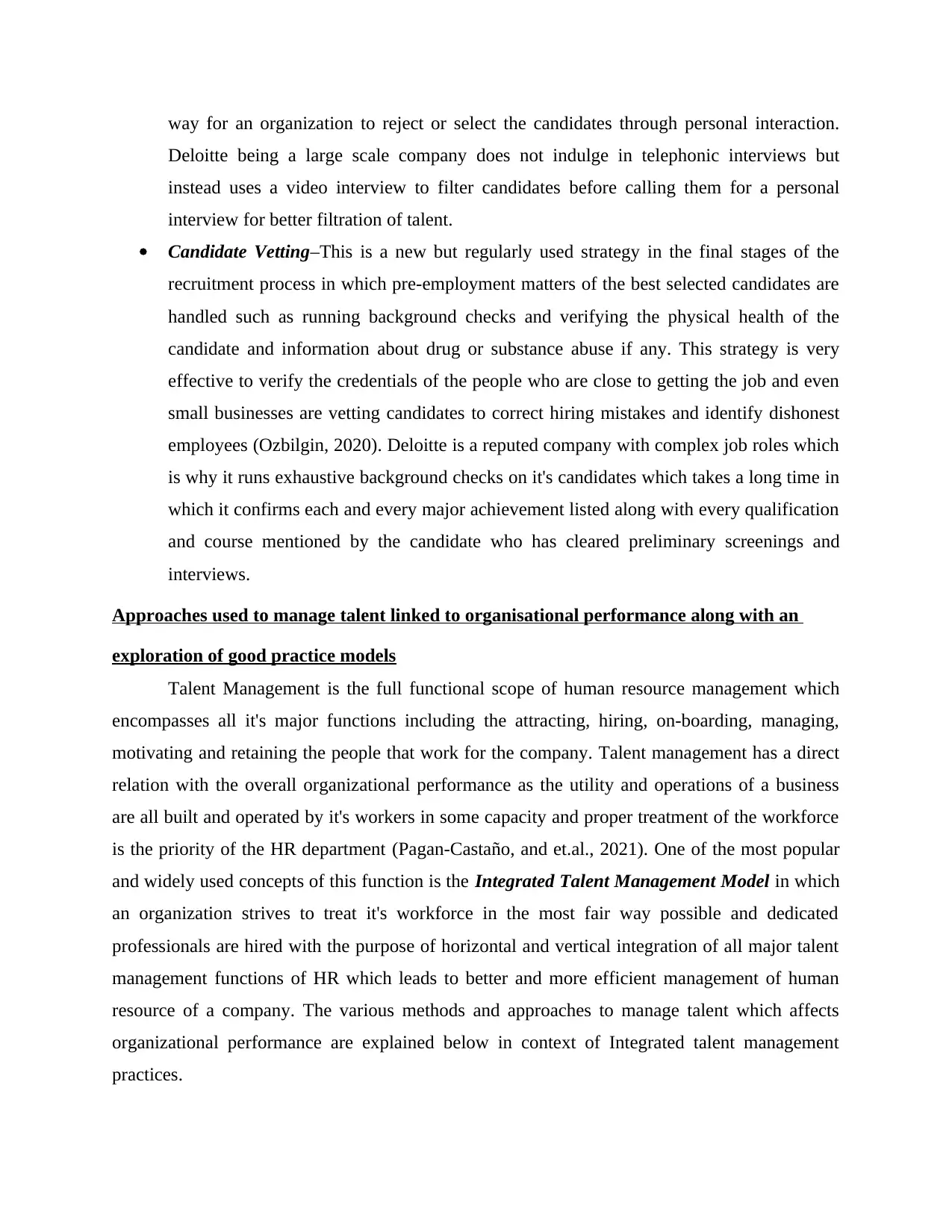
way for an organization to reject or select the candidates through personal interaction.
Deloitte being a large scale company does not indulge in telephonic interviews but
instead uses a video interview to filter candidates before calling them for a personal
interview for better filtration of talent.
Candidate Vetting–This is a new but regularly used strategy in the final stages of the
recruitment process in which pre-employment matters of the best selected candidates are
handled such as running background checks and verifying the physical health of the
candidate and information about drug or substance abuse if any. This strategy is very
effective to verify the credentials of the people who are close to getting the job and even
small businesses are vetting candidates to correct hiring mistakes and identify dishonest
employees (Ozbilgin, 2020). Deloitte is a reputed company with complex job roles which
is why it runs exhaustive background checks on it's candidates which takes a long time in
which it confirms each and every major achievement listed along with every qualification
and course mentioned by the candidate who has cleared preliminary screenings and
interviews.
Approaches used to manage talent linked to organisational performance along with an
exploration of good practice models
Talent Management is the full functional scope of human resource management which
encompasses all it's major functions including the attracting, hiring, on-boarding, managing,
motivating and retaining the people that work for the company. Talent management has a direct
relation with the overall organizational performance as the utility and operations of a business
are all built and operated by it's workers in some capacity and proper treatment of the workforce
is the priority of the HR department (Pagan-Castaño, and et.al., 2021). One of the most popular
and widely used concepts of this function is the Integrated Talent Management Model in which
an organization strives to treat it's workforce in the most fair way possible and dedicated
professionals are hired with the purpose of horizontal and vertical integration of all major talent
management functions of HR which leads to better and more efficient management of human
resource of a company. The various methods and approaches to manage talent which affects
organizational performance are explained below in context of Integrated talent management
practices.
Deloitte being a large scale company does not indulge in telephonic interviews but
instead uses a video interview to filter candidates before calling them for a personal
interview for better filtration of talent.
Candidate Vetting–This is a new but regularly used strategy in the final stages of the
recruitment process in which pre-employment matters of the best selected candidates are
handled such as running background checks and verifying the physical health of the
candidate and information about drug or substance abuse if any. This strategy is very
effective to verify the credentials of the people who are close to getting the job and even
small businesses are vetting candidates to correct hiring mistakes and identify dishonest
employees (Ozbilgin, 2020). Deloitte is a reputed company with complex job roles which
is why it runs exhaustive background checks on it's candidates which takes a long time in
which it confirms each and every major achievement listed along with every qualification
and course mentioned by the candidate who has cleared preliminary screenings and
interviews.
Approaches used to manage talent linked to organisational performance along with an
exploration of good practice models
Talent Management is the full functional scope of human resource management which
encompasses all it's major functions including the attracting, hiring, on-boarding, managing,
motivating and retaining the people that work for the company. Talent management has a direct
relation with the overall organizational performance as the utility and operations of a business
are all built and operated by it's workers in some capacity and proper treatment of the workforce
is the priority of the HR department (Pagan-Castaño, and et.al., 2021). One of the most popular
and widely used concepts of this function is the Integrated Talent Management Model in which
an organization strives to treat it's workforce in the most fair way possible and dedicated
professionals are hired with the purpose of horizontal and vertical integration of all major talent
management functions of HR which leads to better and more efficient management of human
resource of a company. The various methods and approaches to manage talent which affects
organizational performance are explained below in context of Integrated talent management
practices.
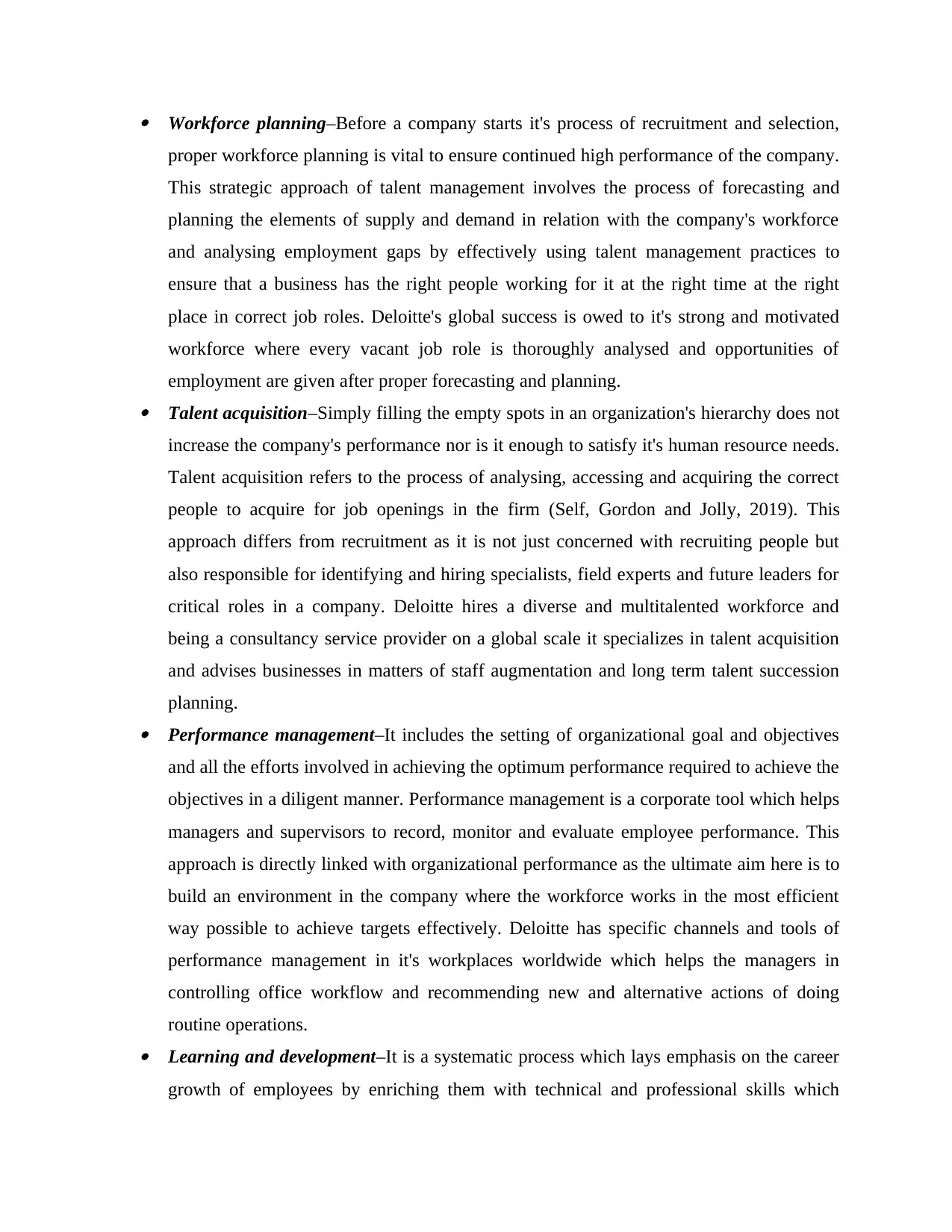
Workforce planning–Before a company starts it's process of recruitment and selection,
proper workforce planning is vital to ensure continued high performance of the company.
This strategic approach of talent management involves the process of forecasting and
planning the elements of supply and demand in relation with the company's workforce
and analysing employment gaps by effectively using talent management practices to
ensure that a business has the right people working for it at the right time at the right
place in correct job roles. Deloitte's global success is owed to it's strong and motivated
workforce where every vacant job role is thoroughly analysed and opportunities of
employment are given after proper forecasting and planning. Talent acquisition–Simply filling the empty spots in an organization's hierarchy does not
increase the company's performance nor is it enough to satisfy it's human resource needs.
Talent acquisition refers to the process of analysing, accessing and acquiring the correct
people to acquire for job openings in the firm (Self, Gordon and Jolly, 2019). This
approach differs from recruitment as it is not just concerned with recruiting people but
also responsible for identifying and hiring specialists, field experts and future leaders for
critical roles in a company. Deloitte hires a diverse and multitalented workforce and
being a consultancy service provider on a global scale it specializes in talent acquisition
and advises businesses in matters of staff augmentation and long term talent succession
planning. Performance management–It includes the setting of organizational goal and objectives
and all the efforts involved in achieving the optimum performance required to achieve the
objectives in a diligent manner. Performance management is a corporate tool which helps
managers and supervisors to record, monitor and evaluate employee performance. This
approach is directly linked with organizational performance as the ultimate aim here is to
build an environment in the company where the workforce works in the most efficient
way possible to achieve targets effectively. Deloitte has specific channels and tools of
performance management in it's workplaces worldwide which helps the managers in
controlling office workflow and recommending new and alternative actions of doing
routine operations. Learning and development–It is a systematic process which lays emphasis on the career
growth of employees by enriching them with technical and professional skills which
proper workforce planning is vital to ensure continued high performance of the company.
This strategic approach of talent management involves the process of forecasting and
planning the elements of supply and demand in relation with the company's workforce
and analysing employment gaps by effectively using talent management practices to
ensure that a business has the right people working for it at the right time at the right
place in correct job roles. Deloitte's global success is owed to it's strong and motivated
workforce where every vacant job role is thoroughly analysed and opportunities of
employment are given after proper forecasting and planning. Talent acquisition–Simply filling the empty spots in an organization's hierarchy does not
increase the company's performance nor is it enough to satisfy it's human resource needs.
Talent acquisition refers to the process of analysing, accessing and acquiring the correct
people to acquire for job openings in the firm (Self, Gordon and Jolly, 2019). This
approach differs from recruitment as it is not just concerned with recruiting people but
also responsible for identifying and hiring specialists, field experts and future leaders for
critical roles in a company. Deloitte hires a diverse and multitalented workforce and
being a consultancy service provider on a global scale it specializes in talent acquisition
and advises businesses in matters of staff augmentation and long term talent succession
planning. Performance management–It includes the setting of organizational goal and objectives
and all the efforts involved in achieving the optimum performance required to achieve the
objectives in a diligent manner. Performance management is a corporate tool which helps
managers and supervisors to record, monitor and evaluate employee performance. This
approach is directly linked with organizational performance as the ultimate aim here is to
build an environment in the company where the workforce works in the most efficient
way possible to achieve targets effectively. Deloitte has specific channels and tools of
performance management in it's workplaces worldwide which helps the managers in
controlling office workflow and recommending new and alternative actions of doing
routine operations. Learning and development–It is a systematic process which lays emphasis on the career
growth of employees by enriching them with technical and professional skills which
⊘ This is a preview!⊘
Do you want full access?
Subscribe today to unlock all pages.

Trusted by 1+ million students worldwide
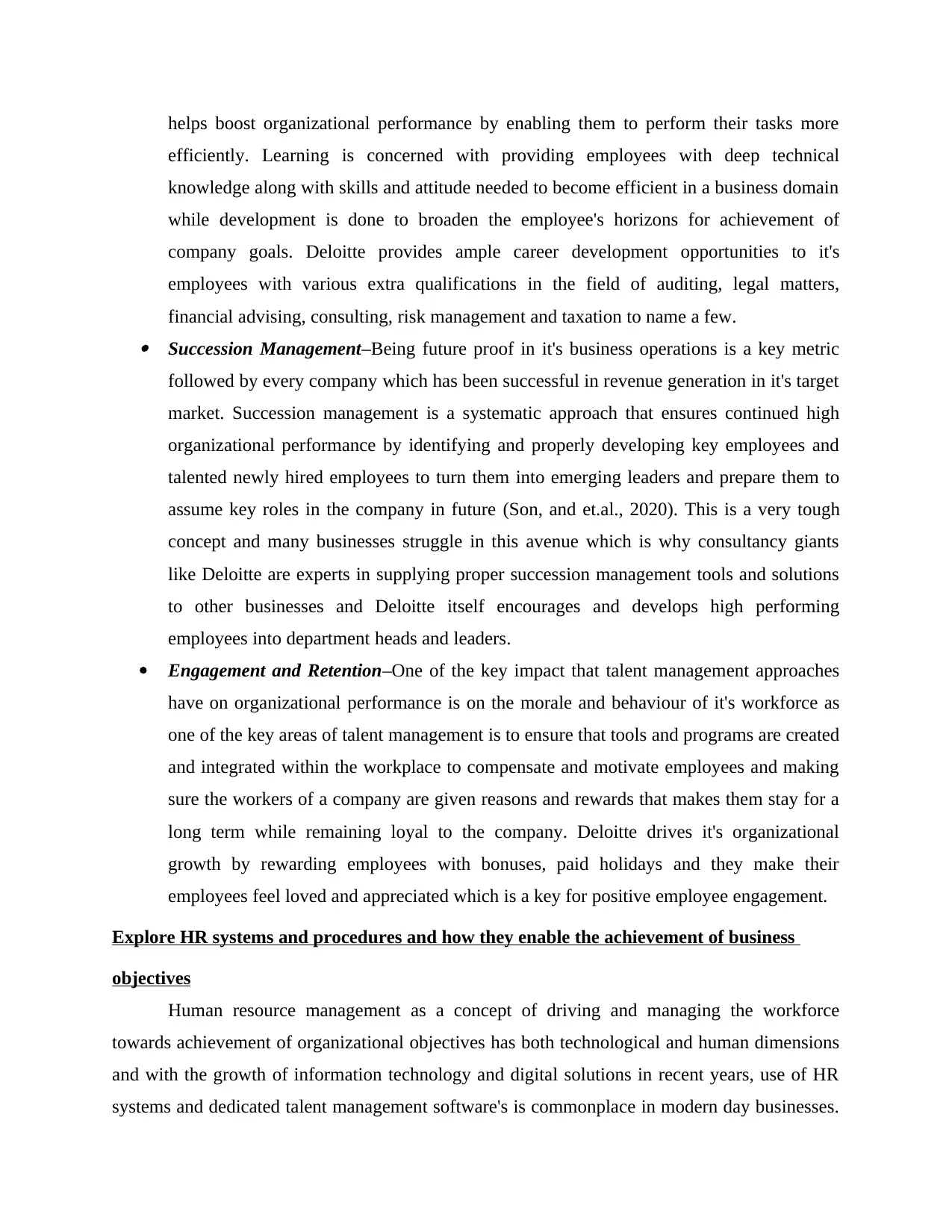
helps boost organizational performance by enabling them to perform their tasks more
efficiently. Learning is concerned with providing employees with deep technical
knowledge along with skills and attitude needed to become efficient in a business domain
while development is done to broaden the employee's horizons for achievement of
company goals. Deloitte provides ample career development opportunities to it's
employees with various extra qualifications in the field of auditing, legal matters,
financial advising, consulting, risk management and taxation to name a few. Succession Management–Being future proof in it's business operations is a key metric
followed by every company which has been successful in revenue generation in it's target
market. Succession management is a systematic approach that ensures continued high
organizational performance by identifying and properly developing key employees and
talented newly hired employees to turn them into emerging leaders and prepare them to
assume key roles in the company in future (Son, and et.al., 2020). This is a very tough
concept and many businesses struggle in this avenue which is why consultancy giants
like Deloitte are experts in supplying proper succession management tools and solutions
to other businesses and Deloitte itself encourages and develops high performing
employees into department heads and leaders.
Engagement and Retention–One of the key impact that talent management approaches
have on organizational performance is on the morale and behaviour of it's workforce as
one of the key areas of talent management is to ensure that tools and programs are created
and integrated within the workplace to compensate and motivate employees and making
sure the workers of a company are given reasons and rewards that makes them stay for a
long term while remaining loyal to the company. Deloitte drives it's organizational
growth by rewarding employees with bonuses, paid holidays and they make their
employees feel loved and appreciated which is a key for positive employee engagement.
Explore HR systems and procedures and how they enable the achievement of business
objectives
Human resource management as a concept of driving and managing the workforce
towards achievement of organizational objectives has both technological and human dimensions
and with the growth of information technology and digital solutions in recent years, use of HR
systems and dedicated talent management software's is commonplace in modern day businesses.
efficiently. Learning is concerned with providing employees with deep technical
knowledge along with skills and attitude needed to become efficient in a business domain
while development is done to broaden the employee's horizons for achievement of
company goals. Deloitte provides ample career development opportunities to it's
employees with various extra qualifications in the field of auditing, legal matters,
financial advising, consulting, risk management and taxation to name a few. Succession Management–Being future proof in it's business operations is a key metric
followed by every company which has been successful in revenue generation in it's target
market. Succession management is a systematic approach that ensures continued high
organizational performance by identifying and properly developing key employees and
talented newly hired employees to turn them into emerging leaders and prepare them to
assume key roles in the company in future (Son, and et.al., 2020). This is a very tough
concept and many businesses struggle in this avenue which is why consultancy giants
like Deloitte are experts in supplying proper succession management tools and solutions
to other businesses and Deloitte itself encourages and develops high performing
employees into department heads and leaders.
Engagement and Retention–One of the key impact that talent management approaches
have on organizational performance is on the morale and behaviour of it's workforce as
one of the key areas of talent management is to ensure that tools and programs are created
and integrated within the workplace to compensate and motivate employees and making
sure the workers of a company are given reasons and rewards that makes them stay for a
long term while remaining loyal to the company. Deloitte drives it's organizational
growth by rewarding employees with bonuses, paid holidays and they make their
employees feel loved and appreciated which is a key for positive employee engagement.
Explore HR systems and procedures and how they enable the achievement of business
objectives
Human resource management as a concept of driving and managing the workforce
towards achievement of organizational objectives has both technological and human dimensions
and with the growth of information technology and digital solutions in recent years, use of HR
systems and dedicated talent management software's is commonplace in modern day businesses.
Paraphrase This Document
Need a fresh take? Get an instant paraphrase of this document with our AI Paraphraser
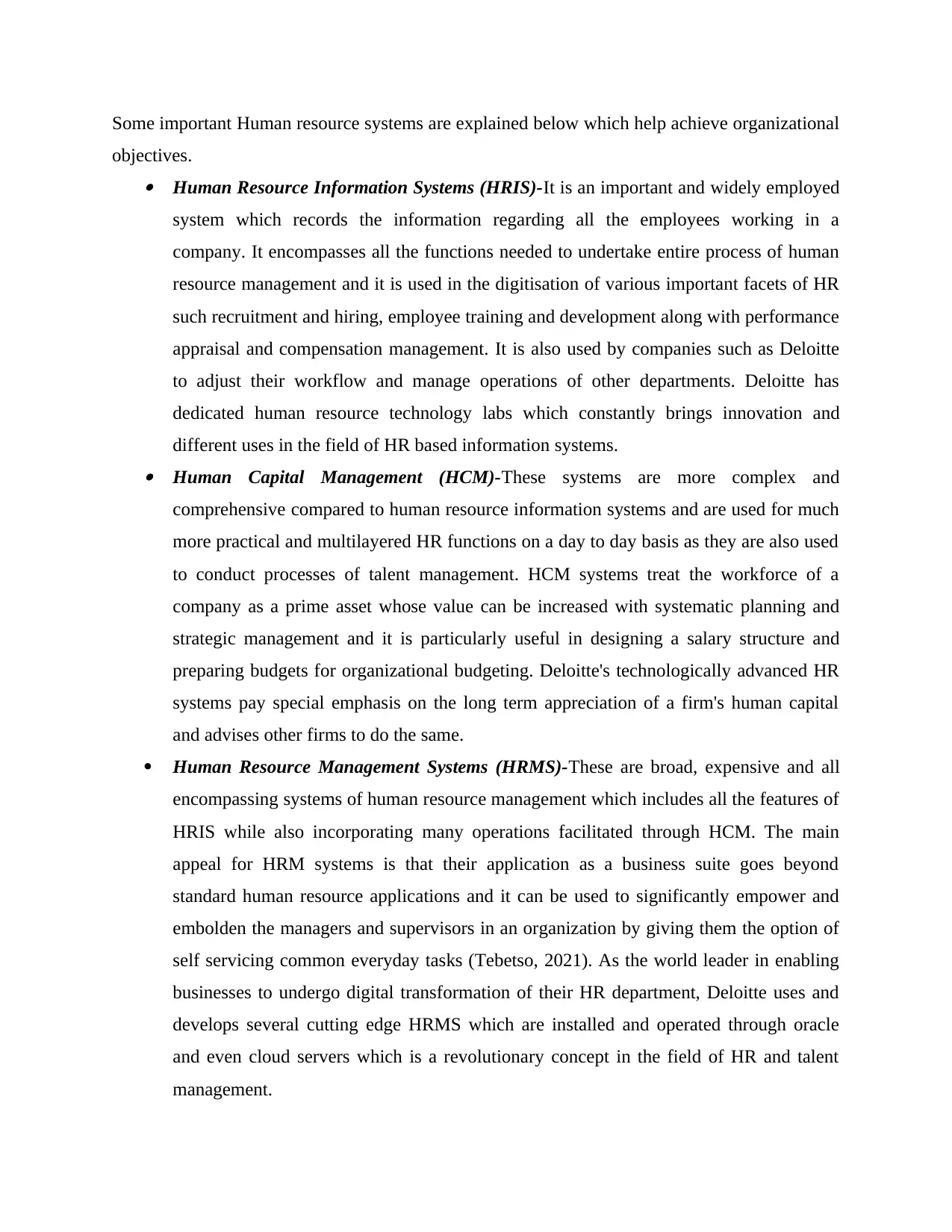
Some important Human resource systems are explained below which help achieve organizational
objectives. Human Resource Information Systems (HRIS)-It is an important and widely employed
system which records the information regarding all the employees working in a
company. It encompasses all the functions needed to undertake entire process of human
resource management and it is used in the digitisation of various important facets of HR
such recruitment and hiring, employee training and development along with performance
appraisal and compensation management. It is also used by companies such as Deloitte
to adjust their workflow and manage operations of other departments. Deloitte has
dedicated human resource technology labs which constantly brings innovation and
different uses in the field of HR based information systems. Human Capital Management (HCM)-These systems are more complex and
comprehensive compared to human resource information systems and are used for much
more practical and multilayered HR functions on a day to day basis as they are also used
to conduct processes of talent management. HCM systems treat the workforce of a
company as a prime asset whose value can be increased with systematic planning and
strategic management and it is particularly useful in designing a salary structure and
preparing budgets for organizational budgeting. Deloitte's technologically advanced HR
systems pay special emphasis on the long term appreciation of a firm's human capital
and advises other firms to do the same.
Human Resource Management Systems (HRMS)-These are broad, expensive and all
encompassing systems of human resource management which includes all the features of
HRIS while also incorporating many operations facilitated through HCM. The main
appeal for HRM systems is that their application as a business suite goes beyond
standard human resource applications and it can be used to significantly empower and
embolden the managers and supervisors in an organization by giving them the option of
self servicing common everyday tasks (Tebetso, 2021). As the world leader in enabling
businesses to undergo digital transformation of their HR department, Deloitte uses and
develops several cutting edge HRMS which are installed and operated through oracle
and even cloud servers which is a revolutionary concept in the field of HR and talent
management.
objectives. Human Resource Information Systems (HRIS)-It is an important and widely employed
system which records the information regarding all the employees working in a
company. It encompasses all the functions needed to undertake entire process of human
resource management and it is used in the digitisation of various important facets of HR
such recruitment and hiring, employee training and development along with performance
appraisal and compensation management. It is also used by companies such as Deloitte
to adjust their workflow and manage operations of other departments. Deloitte has
dedicated human resource technology labs which constantly brings innovation and
different uses in the field of HR based information systems. Human Capital Management (HCM)-These systems are more complex and
comprehensive compared to human resource information systems and are used for much
more practical and multilayered HR functions on a day to day basis as they are also used
to conduct processes of talent management. HCM systems treat the workforce of a
company as a prime asset whose value can be increased with systematic planning and
strategic management and it is particularly useful in designing a salary structure and
preparing budgets for organizational budgeting. Deloitte's technologically advanced HR
systems pay special emphasis on the long term appreciation of a firm's human capital
and advises other firms to do the same.
Human Resource Management Systems (HRMS)-These are broad, expensive and all
encompassing systems of human resource management which includes all the features of
HRIS while also incorporating many operations facilitated through HCM. The main
appeal for HRM systems is that their application as a business suite goes beyond
standard human resource applications and it can be used to significantly empower and
embolden the managers and supervisors in an organization by giving them the option of
self servicing common everyday tasks (Tebetso, 2021). As the world leader in enabling
businesses to undergo digital transformation of their HR department, Deloitte uses and
develops several cutting edge HRMS which are installed and operated through oracle
and even cloud servers which is a revolutionary concept in the field of HR and talent
management.
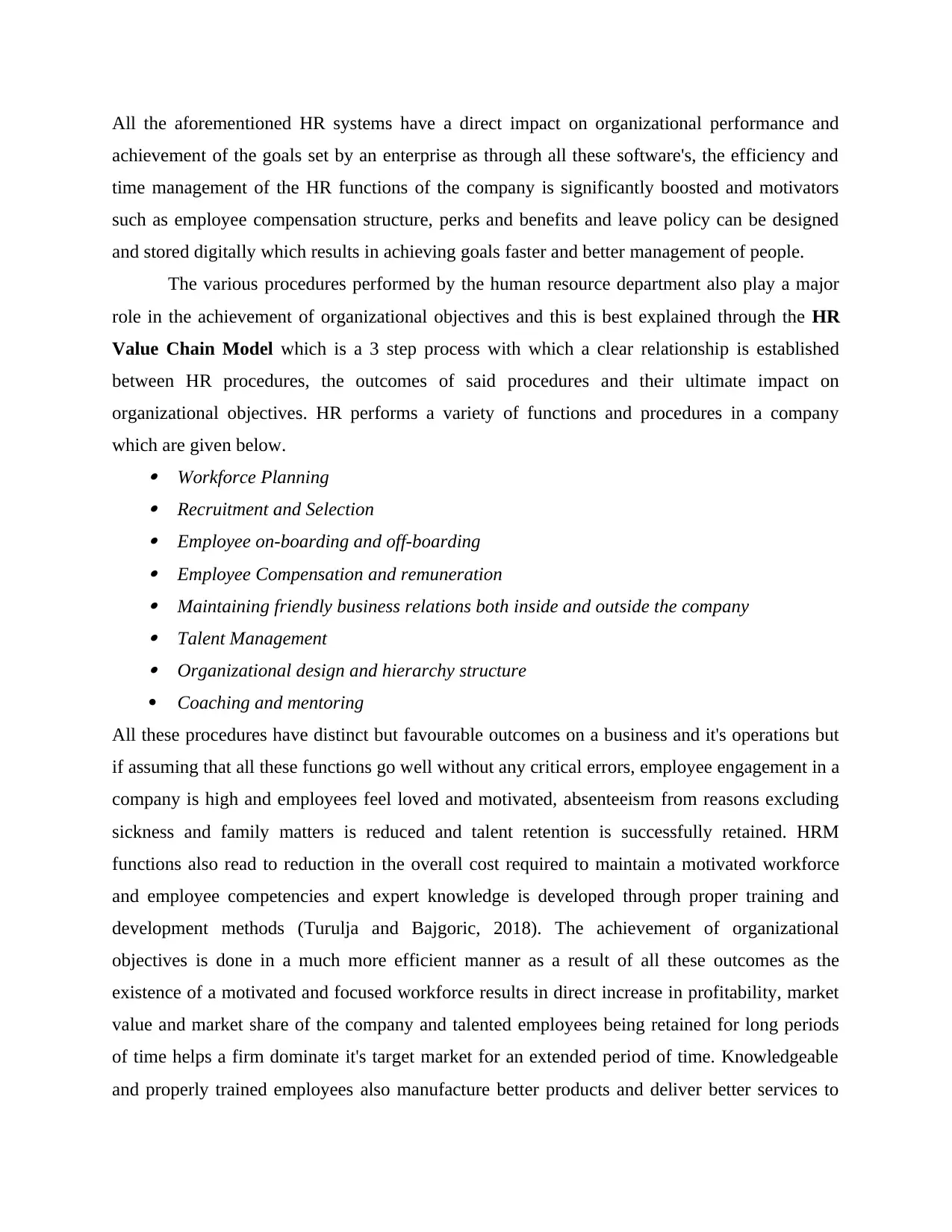
All the aforementioned HR systems have a direct impact on organizational performance and
achievement of the goals set by an enterprise as through all these software's, the efficiency and
time management of the HR functions of the company is significantly boosted and motivators
such as employee compensation structure, perks and benefits and leave policy can be designed
and stored digitally which results in achieving goals faster and better management of people.
The various procedures performed by the human resource department also play a major
role in the achievement of organizational objectives and this is best explained through the HR
Value Chain Model which is a 3 step process with which a clear relationship is established
between HR procedures, the outcomes of said procedures and their ultimate impact on
organizational objectives. HR performs a variety of functions and procedures in a company
which are given below. Workforce Planning Recruitment and Selection Employee on-boarding and off-boarding Employee Compensation and remuneration Maintaining friendly business relations both inside and outside the company Talent Management Organizational design and hierarchy structure
Coaching and mentoring
All these procedures have distinct but favourable outcomes on a business and it's operations but
if assuming that all these functions go well without any critical errors, employee engagement in a
company is high and employees feel loved and motivated, absenteeism from reasons excluding
sickness and family matters is reduced and talent retention is successfully retained. HRM
functions also read to reduction in the overall cost required to maintain a motivated workforce
and employee competencies and expert knowledge is developed through proper training and
development methods (Turulja and Bajgoric, 2018). The achievement of organizational
objectives is done in a much more efficient manner as a result of all these outcomes as the
existence of a motivated and focused workforce results in direct increase in profitability, market
value and market share of the company and talented employees being retained for long periods
of time helps a firm dominate it's target market for an extended period of time. Knowledgeable
and properly trained employees also manufacture better products and deliver better services to
achievement of the goals set by an enterprise as through all these software's, the efficiency and
time management of the HR functions of the company is significantly boosted and motivators
such as employee compensation structure, perks and benefits and leave policy can be designed
and stored digitally which results in achieving goals faster and better management of people.
The various procedures performed by the human resource department also play a major
role in the achievement of organizational objectives and this is best explained through the HR
Value Chain Model which is a 3 step process with which a clear relationship is established
between HR procedures, the outcomes of said procedures and their ultimate impact on
organizational objectives. HR performs a variety of functions and procedures in a company
which are given below. Workforce Planning Recruitment and Selection Employee on-boarding and off-boarding Employee Compensation and remuneration Maintaining friendly business relations both inside and outside the company Talent Management Organizational design and hierarchy structure
Coaching and mentoring
All these procedures have distinct but favourable outcomes on a business and it's operations but
if assuming that all these functions go well without any critical errors, employee engagement in a
company is high and employees feel loved and motivated, absenteeism from reasons excluding
sickness and family matters is reduced and talent retention is successfully retained. HRM
functions also read to reduction in the overall cost required to maintain a motivated workforce
and employee competencies and expert knowledge is developed through proper training and
development methods (Turulja and Bajgoric, 2018). The achievement of organizational
objectives is done in a much more efficient manner as a result of all these outcomes as the
existence of a motivated and focused workforce results in direct increase in profitability, market
value and market share of the company and talented employees being retained for long periods
of time helps a firm dominate it's target market for an extended period of time. Knowledgeable
and properly trained employees also manufacture better products and deliver better services to
⊘ This is a preview!⊘
Do you want full access?
Subscribe today to unlock all pages.

Trusted by 1+ million students worldwide
1 out of 15
Related Documents
Your All-in-One AI-Powered Toolkit for Academic Success.
+13062052269
info@desklib.com
Available 24*7 on WhatsApp / Email
![[object Object]](/_next/static/media/star-bottom.7253800d.svg)
Unlock your academic potential
Copyright © 2020–2025 A2Z Services. All Rights Reserved. Developed and managed by ZUCOL.



